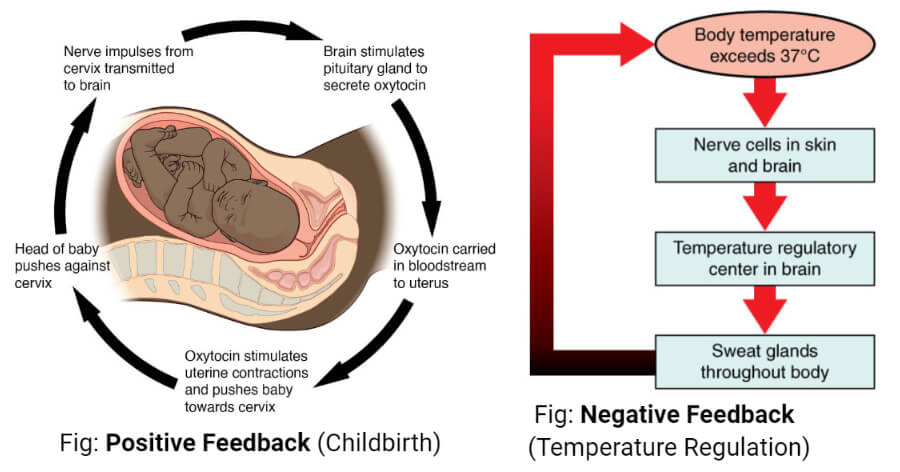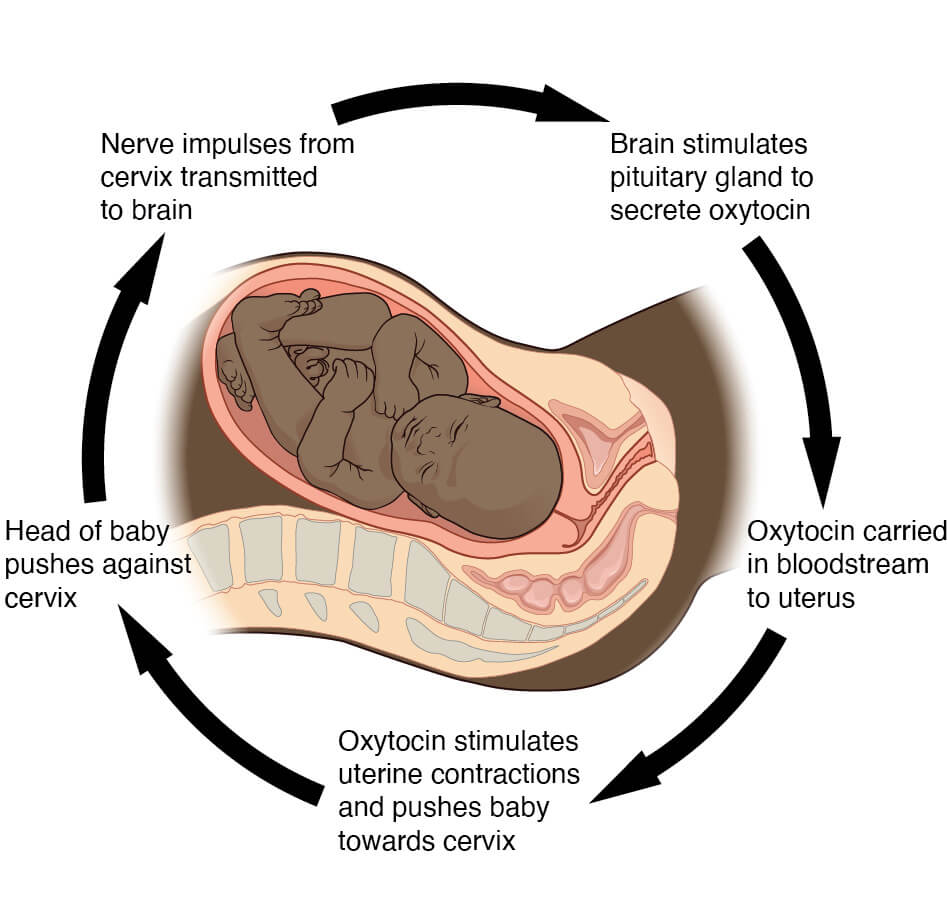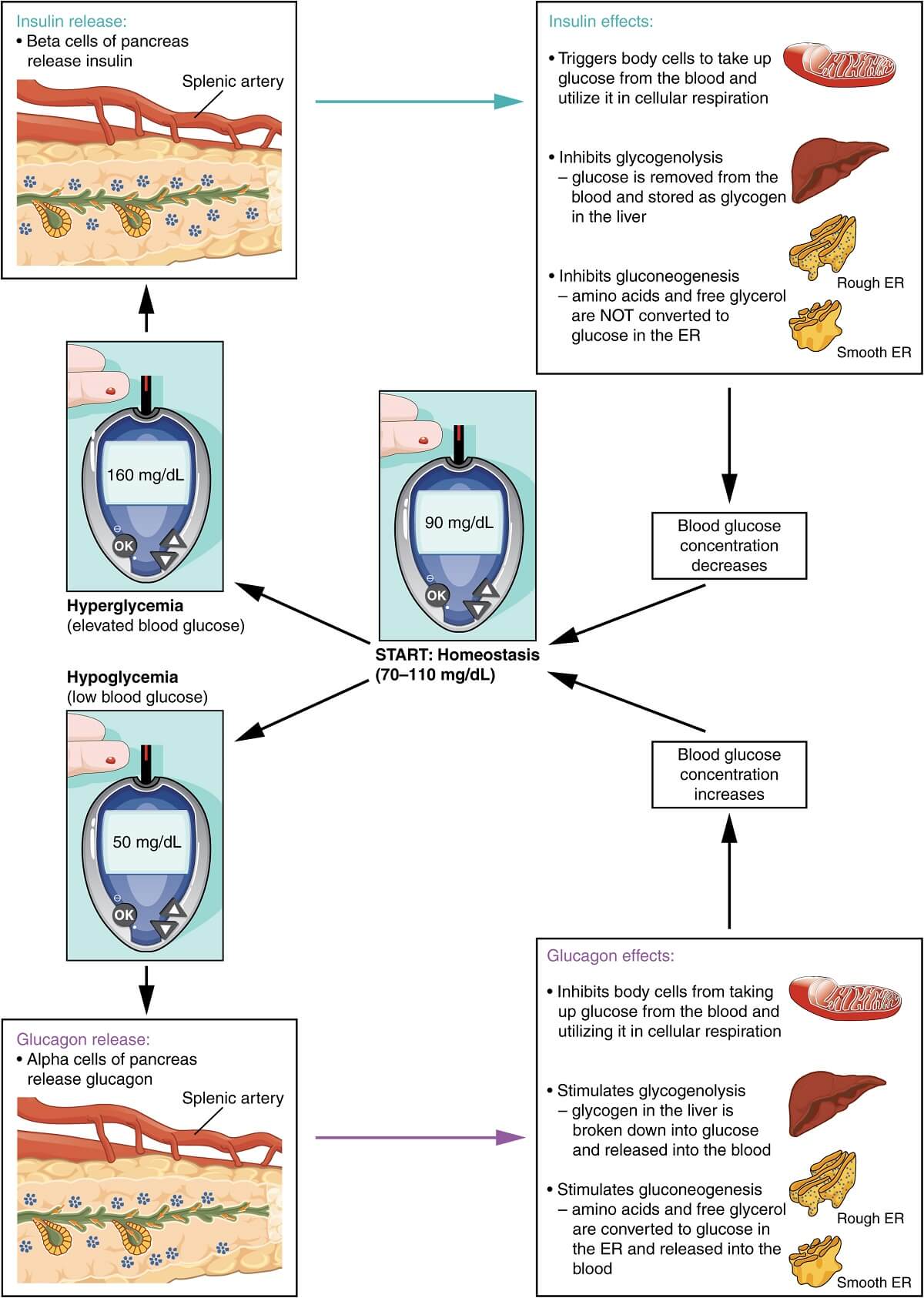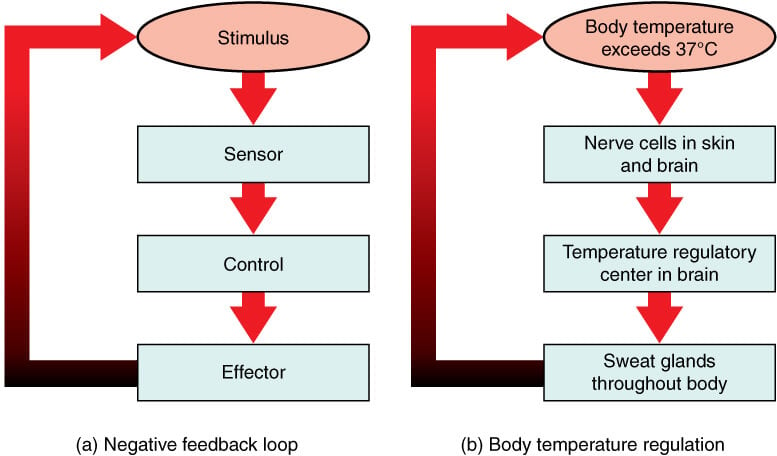The feedback mechanism is the physiological regulatory system in a living body that works to return the body to the normal internal state or homeostasis.
- These mechanisms are also found in nature in different ecosystems and animal groups.
- The feedback mechanism in the living system occurs in the form of a loop which assists in the maintenance of homeostasis.
- The feedback mechanism is activated as a result of the change in the system that triggers an output.
- The biochemical control system in living beings is composed of various components like molecules, genes, and regulatory interactions of such components.
- The interaction between the components can be designated as positive when the activation of a component leads to the activation of another. It is designated negative if the activation of a component leads to the deactivation of another.
- The concept of feedback mechanism was initially introduced in cybernetics to describe the ability of a control system to modify its output as a response to the input.
- In living systems, feedback mechanisms or feedback loops works to bring the body towards homeostasis by either amplifying a specific biological pathway or function or by inhibiting it.
- The most important function of the feedback mechanism in any system is to bring the state of the body into a stable state.
- The feedback mechanism consists of three distinct components; control center, detector, and effector.
- The control center is the ‘brain’ of the system that determines the extremes within which the variable factor should lie.
- The detector or sensor receives the input and integrates the incoming information in order to transmit it to the control center.
- Based on the incoming signals, the control center determines if an adjustment is needed and sends the signal to the effector.
- The effector receives the output and results in an appropriate change to maintain the variable factor within its limit.
- The feedback mechanism is a dynamic process that makes changes continuously to adjust various physiological parameters.
Feedback Mechanism Loop Types
Feedback mechanisms are of two types, depending on the changes in the input or the deviation of the physiological parameters from their limits. Even though these mechanisms are different in their reactions to changes in variables, the components of the loop are similar.

Image Source: OpenStax.
Positive Feedback Mechanism Loop
Definition of Positive Feedback Mechanism
- A positive feedback mechanism, as the name suggests, is a pathway that in response to a deviation in the output causes the output to change even more in the direction of the initial deviation.
- A positive feedback mechanism amplifies the deviations and brings state changes to the output.
- Positive feedback mechanisms are far less common than negative feedback mechanisms as it moves the body away from homeostasis.
- The process of positive feedback mechanism progressively amplifies the response as long as the stimulus is continued.
- The positive feedback loop can consist of either a single component that activates its own activity or several components with direct and indirect interactions.
- Positive feedback loops in biological processes are often observed in processes that need to occur quickly and towards completion as the output tends to increase the effect of the stimulus.
- Positive mechanisms are very few within living systems like the human body, but these can also be observed in the ecosystem, like in the case of ripening of fruit.
Steps / Process / Mechanism of Positive Feedback Mechanism
The process of a positive feedback loop consists of a control system that consists of various components, working in a circular pathway to stimulate or inhibit one another. The overall process can be described in terms of the components of the system.
1. Stimulation
- The first step in the positive feedback loop is the stimulation that sets off the loop in order to complete a process.
- The stimuli in the human body are mostly hormones released by different organs as a result of the initiation of a process.
- An example of a stimulus that initiates a positive feedback mechanism is the contraction during childbirth.
2. Reception
- The second step in the loop is the reception of the stimuli through different sensors that send the information to the control unit.
- These receptors are mostly nerves that send the signal from the site of stimulus to the control unit, which in humans is the brain.
3. Processing
- The next step in the loop is the processing of information sent to the control unit by the receptors.
- The control unit tallies the information to check if the stimulus is outside the normal range of the value and presents an output.
- In the case of childbirth, the brain receives information about the contractions in the uterine wall and then stimulates the secretion of the hormone oxytocin by the pituitary gland.
4. Further activation of the stimuli
- The information from the brain is sent to the site of action via different nerves in order to induce an output in response to the stimulus.
- In the case of the positive feedback loop, the signals from the brain tend to activate the stimulus even further in the direction of deviation.
- The stimulation of the pituitary gland to release oxytocin, which further increases the contractions of muscles in the uterine wall during childbirth is an example of this process.
Examples of Positive Feedback Mechanism
1. Menstrual cycle
- At the beginning of the menstrual cycle, the ovaries release the hormone estrogen. The estrogen acts as a stimulus for the positive feedback loop.
- The information is sent to the brain, which then stimulates the release of gonadotrophin-releasing hormone from the hypothalamus and luteinizing hormone from the pituitary.
- These hormones are released as a response to the stimulus by the control unit. These hormones further cause the release of estrogen by the ovaries, and the loop continues until the levels of these hormones increases enough to induce the release of follicle-stimulating hormone.
- The release of follicle-stimulating hormone finally results in ovulation, and eventually, the menstrual cycle begins.
- This is an example of a positive feedback mechanism as the increase in one factor induces the movement of the output in the same direction until the task is completed.
2. Childbirth

Figure: Normal childbirth is driven by a positive feedback loop. A positive feedback loop results in a change in the body’s status, rather than a return to homeostasis. Image Source: OpenStax.
- Positive feedback mechanism in humans is also observed during childbirth which is induced by the pressing of the ovarian wall by the baby.
- The pressing sensation is passed to the brain via different nerves, and in response, the brain stimulates the pituitary to produce oxytocin.
- Oxytocin is responsible for the contractions of the uterine muscles which cause the movement of the fetus towards the cervix, further increasing the stimulus.
- The positive feedback loop continues until the baby is born.
Negative Feedback Mechanism Loop
Definition of Negative Feedback Mechanism
- A negative feedback mechanism or loop is a pathway stimulated by the deviation in the output, which causes changes in output to the direction opposite to the initial deviation.
- The negative feedback mechanism moves the variable factors towards the stable state or homeostasis after the control unit interprets the extent of the deviation.
- Negative feedback loops are more common than positive ones as they tend to stabilize the system.
- The loop detects the change in output and acts in the opposite direction to nullify the stimulus causing the change.
- These loops are activated under two conditions; when the value of the variable is above the normal value and has to be brought down and when the value of the variable is below the normal values and has to be brought up.
- Negative feedback mechanisms occur as a part of homeostasis to bring the variables back to their normal levels by counteracting the stimulus, causing the deviation in the first place.
- Like in a positive feedback mechanism, a negative feedback mechanism also contains different components that together help to maintain a stable state.
Steps / Process / Mechanism of Negative Feedback Mechanism
The process of negative feedback mechanism is similar to the positive feedback loop as the process is activated by stimuli, which eventually leads to changes that tend to nullify those stimuli. The overall process can be described as below:
1. Stimulation
- The first step of the negative feedback loop is the generation of stimuli as a result of the deviation of physiological parameters from the normal value. The deviation of physiological parameters can occur at either extreme.
- The deviation might either require the activation or inhibition of different physiological activities of the body to maintain the normal state.
- The most common and easily understood stimulus is the change in body temperature away from the normal limit.
2. Reception
- The changes in the physiological parameters are received by the control unit via different receptors present in different parts of the body.
- Some of the common receptors involved in the transmission of stimulus include nerves and other thermoreceptors.
3. Processing
- The control unit of the loop is the brain which first determines if the change in the physiological parameter requires activation of inhibition of the loop.
- Depending on the direction of deviation, the brain sends out signals to undo the changes via different mechanisms.
- In the case of changes in body temperature, the group of cells in the hypothalamus of the brain acts as the control unit.
4. Counteract on the stimulus
- As the final step of the loop, the control unit sends out signals to nullify the effects causing changes in the physiological factors.
- The changes can be of different types and directed towards different parts of the body. The information is sent to different organs via the nervous system.
- In the case of a decrease in body temperature, the hypothalamus sends out signals resulting in shivering, constriction of blood vessels, and behavioral changes like curling up.
- These activities result in an increase in body temperature, which then inhibits the loop, and the process is complete until the body temperature decreases again.
Examples of Negative Feedback Mechanism
1. Regulation of blood glucose level
- The level of glucose in the blood is controlled by a negative feedback mechanism.
- If the blood glucose level increases beyond the normal range, more glucose is absorbed in the intestine and stored in the form of glycogen in the liver.
- The conversion and conservation are controlled by the release of insulin from the pancreas. The hormone insulin stimulates the muscles and liver to uptake the glucose.
- If the blood glucose level decreases and more glucose is required in the blood, the release of insulin is inhibited, reducing the absorption of blood glucose.

Figure: Regulation of blood glucose level. Image Source: OpenStax.
2. Temperature regulation
- Regulation of body temperature by endotherms is another classic example of a negative feedback mechanism in the human body.
- When the temperature of the body increases beyond normal, the brain signals different organs of the body like the skin to release heat in the form of sweat.
- These physiological activities eventually the temperature to drop down to a point where the pathways of the negative feedback mechanism shut down.
- A similar process occurs if the body temperature increases beyond the normal value in order to maintain homeostasis.

Figure: In a negative feedback loop, a stimulus—a deviation from a set point—is resisted through a physiological process that returns the body to homeostasis. (a) A negative feedback loop has four basic parts. (b) Body temperature is regulated by negative feedback. Image Source: OpenStax.
Applications of Feedback mechanism
Feedback mechanism has applications in different systems and areas for different purposes.
- In biology, feedback mechanisms are involved in the maintenance of homeostasis in organisms as well as ecosystems. Both positive and negative feedback mechanisms are involved in homeostasis, but negative feedback mechanism is more common.
- The feedback mechanism is utilized in mathematics and dynamic systems to alter the behavior of different systems as per the need of the application.
- Different studies on climate science have been performed by the use of positive and negative feedback mechanisms to observe the effect on the atmosphere, ocean, and land.
- The most common application of feedback mechanism is in electronic engineering where the mechanism is used in components like amplifiers, oscillators, and logic circuits.
Positive vs. Negative Feedback Loop (8 Key Differences)
| Characteristics | Positive Feedback Loop | Negative Feedback Loop |
| Definition | The positive feedback mechanism is a pathway that in response to a deviation in the output causes the output to change even more in the direction of the initial deviation. | A negative feedback mechanism or loop is a pathway stimulated by the deviation in the output, which causes changes in output to the direction opposite to the initial deviation. |
| Effect on the homeostasis | A positive feedback mechanism breaks down the homeostasis system of the body. | A negative feedback mechanism works to maintain the conditions of homeostasis in the body. |
| Occurrence | The positive feedback mechanism is less common and occurs in specific situations. | The negative feedback mechanism is more common and occurs in different organs and systems in the body. |
| Stability | The positive feedback mechanism is less stable. | The negative feedback mechanism is more stable. |
| Effect | In a system with a positive feedback mechanism, the effective input is increased by the addition of actual input with the feedback signal. | In a system with a negative feedback mechanism, the effective input is decreased as the feedback signal inhibits the actual input. |
| External interruption | A positive feedback mechanism might require an external interruption. | A negative feedback mechanism doesn’t require an external interruption. |
| Changes | It enhances the change in physiological factors. | It resists changes in physiological factors. |
| Examples | Positive feedback mechanism in nature is observed during childbirth in humans and during the ripening of fruits. | The negative feedback mechanism is observed during thermoregulation and maintaining the blood glucose level. |
References
- Waugh A and Grant A. (2004) Anatomy and Physiology. Ninth Edition. Churchill Livingstone.
- Mitrophanov, Alexander Y, and Eduardo A Groisman. “Positive feedback in cellular control systems.” BioEssays: news and reviews in molecular, cellular and developmental biology vol. 30,6 (2008): 542-55. doi:10.1002/bies.20769
- Fagerlund, Riku et al. “Anatomy of a negative feedback loop: the case of IκBα.” Journal of the Royal Society, Interface vol. 12,110 (2015): 0262. doi:10.1098/rsif.2015.0262
- Libretti S, Puckett Y. Physiology, Homeostasis. [Updated 2020 Jun 21]. In: StatPearls [Internet]. Treasure Island (FL): StatPearls Publishing; 2020 Jan-. Available from: https://www.ncbi.nlm.nih.gov/books/NBK559138/
- Torday, John S. “Homeostasis as the Mechanism of Evolution.” Biology vol. 4,3 573-90. 15 Sep. 2015, doi:10.3390/biology4030573
- APPLICATIONS OF FEEDBACK SYSTEMS. In The Commonwealth and International Library: Applied Electricity and Electronics Division. Electronic Engineering Applications of Two-Port Networks. Pergamon. 1976. Pages 171-207. https://doi.org/10.1016/B978-0-08-018069-4.50015-1.
- Lehrer, Paul, and David Eddie. “Dynamic processes in regulation and some implications for biofeedback and biobehavioral interventions.” Applied psychophysiology and biofeedback vol. 38,2 (2013): 143-55. doi:10.1007/s10484-013-9217-6
- Liu, Wang et al. “Application of Feedback System Control Optimization Technique in Combined Use of Dual Antiplatelet Therapy and Herbal Medicines.” Frontiers in physiology vol. 9 491. 4 May. 2018, doi:10.3389/fphys.2018.00491
- Rahman, Anisur et al. “Importance of Feedback and Feedforward Loops to Adaptive Immune Response Modeling.” CPT: pharmacometrics & systems pharmacology vol. 7,10 (2018): 621-628. doi:10.1002/psp4.12352
